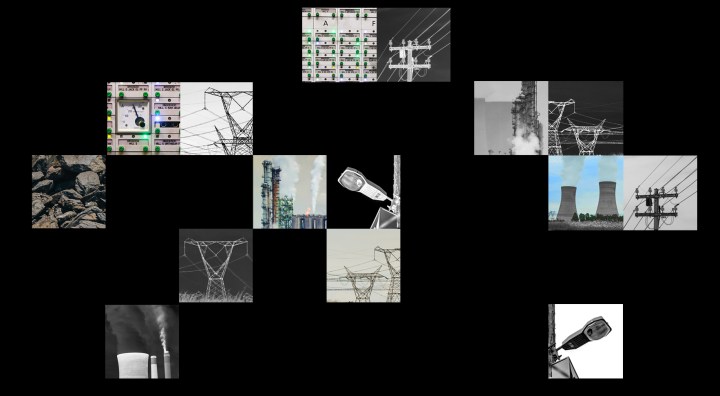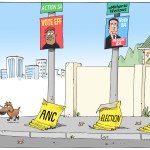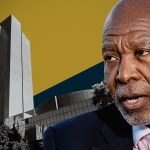POWER CRISIS
Private sector may have to foot R200bn for expanding SA’s electricity grid

Eskom estimates it will cost R200bn within the next 10 years to expand South Africa’s electricity infrastructure to accommodate renewable energy projects and end blackouts. The private sector will probably foot this bill.
The lack of grid capacity and aged electricity infrastructure in South Africa are significant impediments to addressing Eskom blackouts and are delaying South Africa’s transition to renewables.
There is no capacity in the existing infrastructure, mainly high-voltage lines, in the Western Cape, Eastern Cape and Northern Cape to connect to the grid the renewable energy produced by private players.
These areas, with abundant natural resources, have many renewable energy players waiting to generate electricity (mainly wind and solar photovoltaic) and connect it to the grid, but they cannot do so because of the lack of grid capacity and access.
Eskom estimates that it will cost at least R200-billion within the next 10 years to expand the grid with 14,200km of high-voltage lines and 170 transformers to accommodate new electricity generation capacity. This is money that the power utility and the government do not have.
Research by the think tanks Meridian Economics and Krutham has suggested that Eskom and the government will have to embrace the private sector to fund investments aimed at expanding the grid.
Two funding models
Meridian Economics and Krutham have suggested two funding models, which involve private sector players financing the expansion of the electricity grid. After all, private capital remains ready to potentially end Eskom blackouts by investing in renewable energy projects (as seen in the past two years after the government allowed companies to build power plants of any size to meet their own electricity needs).
The first funding model is premised on a build, own, operate and transfer model for private sector investments in the grid. The state, through the National Transmission Company (recently unbundled from Eskom to manage the national electricity grid), could run a procurement auction process to appoint companies on a 20- to 30-year period, whereby they will undertake the financing, construction and operations of the grid (or transmission lines).
Under an agreement with the National Transmission Company, companies would be obliged to maintain and operate the transmission infrastructure for a specific period after construction. After the 20- to 30-year period, the ownership and operational and maintenance responsibilities would be transferred back to the National Transmission Company. During this period, it is assumed that the private sector would also be able to use the expanded and improved infrastructure to generate electricity and potentially supply it to the national grid, ending blackouts in the process.
The two think tanks said this funding model would transfer the capital or funding requirements (and risk) to the private sector and away from the government or Eskom.
“It [the first funding model] is developed from two key observations: Eskom is not creditworthy in its current state and does not have adequate execution capacity given the size of the challenge. Therefore, innovative ways of containing costs and allocating risk will be required to limit the reliance on sovereign [public finance] support,” Meridian Economics and Krutham noted.
Eskom’s financial situation remains dire. The power utility incurred a whopping R23.9-billion financial loss in the year ending March 2023 — the largest in its 100-year operational history.
Read more in Daily Maverick: Eskom posts record R23.9bn financial loss
Another pressure point is Eskom’s inability to recover electricity payments from municipalities. Municipal debt has continued to escalate to unsustainably high levels, amounting to R58.5-billion in 2023. Debt and interest costs are still a big problem for Eskom, weighing on its money-generation potential. Its debt stock swelled to R423.9-billion, with the National Treasury taking over a portion of it.
The involvement of independent power producers
The second funding model for the electricity grid that Meridian Economics and Krutham have proposed would be backed by independent power producers (IPPs), such as those producing wind and solar photovoltaic energy. With the help of a private grid company, IPPs would be part of building and operating electricity infrastructure such as grid lines and substations.
The private grid company would connect “multiple [or other] IPP projects that pay to use grid and substation infrastructure. These IPPs have their own private off-takers for the energy that they provide either through PPAs [power purchase agreements] or through selling on to the market.”
This model is premised on the fact that IPPs already spend a lot of money on electricity infrastructure to set up their renewable energy projects, and are exposed to the risk of infrastructure investments.
“IPPs currently absorb the costs of building 132kV [kilovolts] lines to connect to substations on the 400kV network and then hand over the assets to Eskom with no reimbursement of the cost.”
The issue of grid expansion will have to be decided by many players. There is the Eskom management and board. Then in the government, there is Electricity Minister Kgosientsho Ramokgopa, Public Enterprises Minister Pravin Gordhan (in charge of Eskom’s governance affairs), Mineral Resources and Energy Minister Gwede Mantashe (who has powers to procure additional electricity from coal, nuclear and renewable energy sources), Minister of Forestry, Fisheries and the Environment Barbara Creecy (responsible for the impact of Eskom and renewable energy affairs on the environment), and Finance Minister Enoch Godongwana (responsible for Eskom’s exposure to public finances).
A source close to business and the government told Daily Maverick that Godongwana and the National Treasury were warming up to proposals for the private sector to take on the cost of expanding the national grid. DM



















“The power utility incurred a whopping R23.9-billion financial loss in the year ending March 2023 — the largest in its 100-year operational history.”
This is how one privatises an SOE, no denying it.
Our economy can’t function nor can it grow without electricity.
So it comes down to this. Whichever way these players decide to go, there is going to be an enormous capital cost, and that has to be paid by someone. That “someone” is not going to be the shareholders of IPPs. It is going to be consumers of electricity, through increased tariffs, or the government, which amounts to the same thing, but through taxes. However, either way is better than bearing the cost of on-going load shedding, so get on with it please!
Maybe we have an informed reader that can clarify. As I have it, new connections pay, in terms of NRS69 a network development fee that is entirely in addition to any physical infrastructure such as cabling and their transformer.
At the MV/HV level that is about R6,000 per kVA. So if we just use kVA = kW then a 10 MW wind/solar farm would pay 10,000 x R6,000 = R60 million. If we’re adding 10GW then that is R60billion. And remember that the IPP also pay for their own cable and transformer substation to the nearest appropriate size transmission network point.
Exactly, the IPP’s supplying wind or solar power must include the provision of all transmission infrastructure required to get their power to the network, in the cost of their new plant. Maybe then the real cost of renewable energy will become more apparent! And while on that topic, the real cost of renewables must take into account that this type of energy is only available for a fraction of the daily 24 hour cycle, so the cost of the backup power, whether this is conventional coal fired, nuclear, hydro or diesel fired OCGT, to keep the lights on when “the sun don’t shine and the wind don’t blow” is more realistically shown to the man on the street.
What I would like to know is why not invest part of these billions into home rooftop solar because it would even out consumption and lessen the need for part of the expansion of the grid. It would partially remove the enormous burden of building all this extra grid. My personal feeling is that there is no interest in this as it would remove the income badly needed by councils around the country. Am I right or wrong here??
Agreed. The need for expanding the grid assumes the need for many large utility scale installations (that require high capacity feed-in points and transmission infrastructure to move the electricity they generate). A more dispersed generation model would reduce the need for this expansion. If storage is added this need goes down even more.
This generation model and related ‘need’ for grid expansion is obviously aligned with players with an interest in this kind of electricity generation and transmission model (large producers and consumers). You have mentioned municipalities on the consumer side. Patrice Motsepe (our president’s billionaire brother in law) has very large business interests in the renewable energy generation sector. Possibly a coincidence, but it always helps to follow the money.
The suggestion of the private sector having to take over Eskom is both wise and the way to go. The existing way its running is more than shocking . After so many years the government led public sector has shown very clearly that it has “stuffed up” !!. Now let the private sector have a go . They are purpose driven ,interested in efficiencies , and have progress as one of their mantra . At the “station” we are all at now in the RSA , ” all change ” is the route to follow ! At least we will know the destination . It wont be easy …but at least let’s do it !!
Agreed. But Eskom/ANC will want to retain control. Who in the private sector would want these failed entities to have the final say? He who pays the piper doesn’t get to call the tune.
The pig headed communists/socialists in the ANC resist private sector involvement in any way possible, other than collecting taxes from it.
Well of course, notwithstanding the cost. Two or three major problems though….. Dealing with and trusting Government and Eskom, and the unions + Municipal debt which is unsustainable + collapse of infrastructure in the Metros and towns.
Good article. A bit misleading though.
1. The industry is not sponsoring anything – these are pure investments. The costs are worked into the capital requirements and finance models of the projects.
2. A lot of the “suggestions” proposed are already in practice for at least the last five years. What ESKOM is busy doing, is expanding the investment model. Ex. currently, through the self-build model, the IPP choose to build and pay for the sub-station (after the CEL or Cost Estimation Letter process). ESKOM is expanding this to the power lines.
3. The process to attain the approval for the CEL is arduous and time consuming. They need to work on this and shorten the time you wait for approval.
4. What is true though, all of this is “sponsored” by the consumer.
Very Misleading. But what you fail to point out is that these private sector Investors will be providing electricity to Eskom at extortionate prices because private sector companies are generally run at double the efficiency and productivity that South African SOE’s are run at. This means they will be selling to Eskom at the price that the consumer should be paying. Eskom will mark up the price to cover there bloated overheads and the looting continues! So yes the consumer pays. This is not a sustainable model! The private producers should be able to compete head 0n with Eskom in a free market. But we know this will never happen in our beloved country while under the governance of the ANC. So the consumers must brace themselves for ever increasing costs, which reminds me, it’s time to load up my pre-paid 😖
The current plan is modelled around the US and the EU and it is a one sided solution albeit probably the only one that will see SA out of the power shortage doldrums. You will purchase power from resellers/dealers/traders whose only contribution will be derisking the supply and for this making a more than handsome profit without investing a single cent in infrastructure which is totally wrong. Traders should be forced to invest a % of their turnover (not profit) in grid stabilisation which could be in the form of batteries, pump storage schemes, hydrogen production and other available technologies. Instead all that will happen as has been the case overseas where the same model has been adopted is super profits for the traders/resellers and those who have shares in them. The best investment you can make is in generating your own power and switching that municipal main switch off even at current interest rates. IS the state were really interested in emancipating the poor it would change this market model to one where users purchase directly from the generators, who pay all and sundry for wheeling their power, then it would easy to provide free power in x amounts to those who cannot afford it. Instead we are following the wrong advice (nothing new or unusual).
Double the efficiency? More like 10 times I feel.
But… the Minister of Electricity said loadshedding will end in the next 18 month??
He did, and the situation is looking better. But that’s not really the issue here, and the issue is not a South African one. Grids all over the place need to expand rapidly so that new sources of power can connect.
Even if load shedding were not a consideration, Eskom would be looking to use solar or wind a lot more, and that means they have to have grid connections in places where the wind blows a lot or the sun shines a lot, and they need to have the capacity on the grid to route that electricity to where it’s needed.
What do you see as looking better exactly? Hopefully you aren’t mislead by the pre-election reduction in blackouts funded by the burning of oceans of diesel. Remember the BRICS summit?
Well we haven’t had load shedding for … what? … two weeks? And, contrary to the rumour mill, Eskom is not burning record amounts of diesel, in fact last time I looked they were going to be about 50% down on OCGT use from this month last year. Now you might say that it won’t last, and you may be right (in fact you will be. Nobody anywhere will give you a guarantee that the whole country will have all the power it needs all the time). Loadshedding may not be totally resolved, but the situation is looking better. Or does two straight weeks with no shedding not look better to you?
“Or does two straight weeks with no shedding not look better to you?”
Against it’s 16 year history two weeks is a statistical anomaly. Nothing has changed wrt to the fundamental problems that existed before this period and we are weeks away from an election where rolling blackouts are a key vote loser for the glorious liberation movement. Even if they aren’t burning lakes of diesel bought from connected cadre middlemen at inflated prices which may be true but is unlikely, I can tell you for free that at the very least maintenance has been canned and the plants are being run ragged to make credulous midwits think things have changed. Lets check in after the election.
Robbing Peter to pay Paul I fear.
Could anyone clarify how the private sector gets to recoup their investment in transmission? Option 2 sounds especially predatory as the IPPs are already ‘exposed to risk’ essentially forcing them to throw even more money at the problem. I would assume Eskom would pay them, with they money the didn’t have to build in the first place. Is this Eskom just taking out another ‘loan’?
Why?
Why must I, as a private sector participant pay to support not only the race grifting, racist nationalist socialists, but the 50 million morons holding the rest of us hostage???
I have solar…why must I care?
You don’t have to. Government will say that these options are available to investors, and investors can take them up or not or say that they need a slightly sweeter deal or whatever.
I have solar too. Now, I have had the lights on in my house for the last 5 years now. Should I not care? Well, again, I don’t HAVE to. But I do. Because it’s about all the people who have to leave home earlier and get home later because the robots don’t work. And they have a greater chance of getting mugged because it’s dark when they get home and the street lights aren’t working. And I’ve seen businesses close down or contract and so people lose jobs. The damage is huge, and I care about that. I don’t want to see that stuff happening. Even if load shedding stops forever today, the damage done to lives and incomes is massive.
Looking at things more selfishly, my savings are here, my property is here, and load shedding is not positive for the value of either of those. I’d like the economy to grow because even if I don’t care about anybody else, I still care about my retirement and the worth of what I will leave in my will. Load shedding is a big, fat brake on the economy.
The private sector is likely to have to lay out a whole lot more than that to fix the chaos the ANC has created in their thirty years, well, twenty five years.
If this expansion is funded by the private sector, those companies must insist on managing the development process and ultimately manage the running of the plants.
As a businessman, that is the only way I could see it.
This article is really about transmission (the grid) more than generation, but the general idea with IPPs is that they do everything necessary to generate (obviously with agreed service levels) at their cost, at their risk, and with them controlling everything, and then they sell the product (electricity) to Eskom at an agreed price.
What’s proposed here is that this model be expanded so that the IPP or a seperate company that just handles transmission would take on the cost of transmission, of getting the power delivered into the grid, but, as stated, they “would be obliged to maintain and operate the transmission infrastructure for a specific period after construction.” So it’s not that they’re allowed to manage the infrastructure, they HAVE to manage and maintain it.
The private sector foots the bill for everything else the glorious liberation movement has run into the ground. Why should electricity infrastructure be any different?
I wish people wouldn’t fall for using the cuddly sounding ‘load shedding’ weasel wordy term which tends to normalise our parlous situation and use ‘rolling blackouts’ because that’s what they are.
What about the odd few billion $$$’s that were promised from G7 countries?
Really, you want the private sector to finance and build the infrastructure and after 20-30 years, it becomes yours? Who will agree to that, the taxpayer?